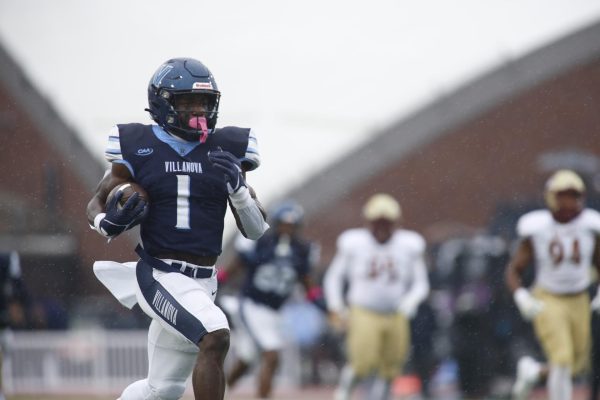Column (Jamie Kapalko): Imagining Super Bowl LXXII, 20 years in advance
February 6, 2008
Super Bowl LXXII
The NFL Commissioner and FOX announced today that this year, for the first time, the championship football game will not be a part of the Super Bowl Sunday broadcast.
“We pay attention to what people want,” the Commissioner said. “And when it comes to the Super Bowl, the game is not at the top of people’s lists. The Super Bowl is about enjoying the festivities with friends and family, good food, entertaining commercials and an incredible halftime show. We’re listening to what America wants.”
Since NBC first decided to televise only parts of Super Bowl LXII 10 years ago – and was met with an overwhelmingly satisfied response – other networks have followed the cue. Last year, CBS chose to limit its game broadcast to clips of touchdown plays and the post-game celebration.
“Last year was a huge success,” the commissioner explained. “This year, we’re just taking it one step further.”
FOX’s show will begin with a pre-game special episode of “American Idol.” The show’s 37th season began airing its “nightmare auditions” in early November – expanded to 12 episodes this year, due to popular demand. Super Bowl Sunday will mark the beginning of the competitive portion of the series, with each of the 12 finalists singing the national anthem. Viewers can vote throughout the night, and the first elimination will be announced during the post-game wrapup.
Following the pre-game show, the first half of the Super Bowl will consist of 90 minutes of commercials. Priced this year at $15 million for 30 seconds, the first half alone will generate $2.7 billion. Adding the second half raises the total to $5.4 billion, or the GDP of Madagascar.
This year’s halftime show is among the most-hyped of all time. FOX, offering an undisclosed sum, managed to coax all four Beatles from the grave to perform with the stars of Disney’s “High School Musical,” whose latest film (“20 Year Reunion”) was released last month. The show will last a full hour and will be the only part of the Super Bowl to take place at Dolphin Stadium in Miami. (The NFL Championship game will be played at a junior college in Boca Raton).
“It’s a bummer that the championship won’t be on TV,” says potential MVP John Moynahan, golden boy of the UPS Browns of Cleveland. “But on the bright side, the game’s early, so we can get home in time for Super Bowl parties.”
Ninety more minutes of advertisements will follow the halftime show, and the post-game special will include analysis of the commercials and conclude with the American Idol results.
During the event’s formative years, the Super Bowl and the NFL Championship were synonymous; the game was the focus, and it only grew beyond that as professional football became more popular. In its infancy, even the halftime show was a modest affair; local college or high school bands provided entertainment for the audience.
In the 1970s and 1980s as viewership increased, advertisers realized that it was an untapped market with great potential. Beginning with Apple’s ad for the Macintosh computer in 1984, the Super Bowl became a stage for innovative and often high-budget commercials. Over the next several decades, Monday morning talk shows began to focus more on analyzing these commercials than the game. The halftime show increased in scale as well, beginning with Michael Jackson’s performance in 1993. U2’s 9/11 tribute in 2002 is widely acknowledged as one of the best halftime shows of all time, followed closely by Britney Spears’s comeback feat in 2012.
Due to the consistent quality of the halftime performances over the following decade, a pattern developed: more and more Americans began to tune in for the show and tune out for the game.
This pattern came as no surprise; it merely reflected in TV ratings what had actually been happening at the Super Bowl for decades. In the late 1970s, people began flocking to the Super Bowl host city for the weekend festivities – even if they didn’t have tickets to the game. They attended events hosted by sponsors, shopped, ate, drank and partied – and flew home Saturday night or Sunday morning to be at Super Bowl parties at home.
In 2008, for example, Audi ran a commercial during the game. But for those actually in Scottsdale, Audi wooed potential customers at an expansive private estate complete with a golf course and cabanas. Maxim and Playboy sponsored celebrity-studded parties with tickets costing thousands of dollars. Guests partied with supermodels at the Victoria’s Secret party Saturday night and nursed their hangovers on the flight home the next morning, leaving Scottsdale before kickoff. The experience encompassed the whole weekend; the game was an afterthought.
It came as no surprise, then, in 2028 when the game was not televised in its entirety. Kickoffs, field goal attempts and all plays begun within 25 yards of the end zone were shown, and commercial footage was interrupted to show breakaway runs and long passes. The halftime show was also extended to a full hour. This change was received warmly by most, with the exception of some players and older fans.
Since then, the transition has been gradual. The complete elimination of the game from the broadcast was an inevitable conclusion. Few people will even notice its disappearance, and little protest has been heard since the announcement.
It is rumored, however, that the NFL’s longest-playing star – a key player in the upcoming championship – is extremely displeased. Allegedly, he threw a fit when he heard the news and has complained that he is disgusted with the NFL’s decision.
Brett Favre could not be reached for comment.










